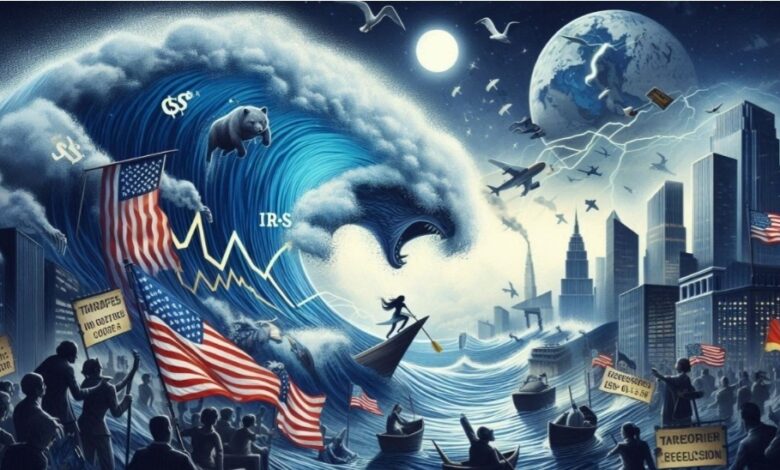Tariff Tsunami: How American Protectionism Ignited a Global Economic Storm

On April 2, local time, U.S. President Donald Trump (hereafter referred to as Trump) announced a baseline tariff of 10% on imports, effective from April 5. He also announced additional tariffs on countries with significant trade deficits, including Cambodia, Laos, Vietnam, China, and South Africa, effective from April 9, with rates ranging from 10% to 49%. On April 9, Trump declared a 90-day suspension of reciprocal tariffs on 75 countries that had not taken “retaliatory” actions, reducing the tax rate to 10%. However, tariffs on China will be raised to 145 percent. How does a tariff war orchestrated by the U.S. trigger a butterfly effect in the global economy? Who will emerge victorious in this conflict, and what will be the next steps? These questions have become the focal point of global attention.
Trade Protectionism: Domino in the global supply chain.
The first domino was that the United States has successively imposed tariffs, which has led to constant turbulence in the global trading system. On January 20,2025, Trump officially took office as the president of the United States, and announced“America First Trade Policy”,Subsequently, an additional 10% tariff on China was imposed on February 4th, another 10% tariff on China on March 4, and a 25% tariff on Mexican and Canadian countries. As of April 16, the tariff on China had climbed to 245%. This policy of “emphasizing protection than cooperation” in the United States has increased the operating cost of the global economy and fueled the wave of economic nationalism. More seriously, according to the report “Global Trade Outlook and Statistics” released by the WTO Secretariat on April 16th, The volume of world merchandise trade will drop by 0.2% in 2025, and if the situation deteriorates further, it will drop to-1.5%.
The second domino is the risk of economic recession caused by the interruption and transfer of global supply chains. As the United States imposes a 25% tariff on cars, Jaguar Land Rover, Audi and other car companies announced the suspension of their export business to the United States. In addition, the shock wave in tariff war has spread to the capital market, with the Standard & Poor’s 500 Index falling below 5,000 points for the first time in the past year, and its market value has evaporated by trillions of dollars. Gbenga Ibikunle, professor and chairman of finance at the University of Edinburgh and director of Edinburgh Financial Innovation Center, said: “In view of the current situation, global economic growth will slow down or decline in the near future, depending on the severity of policy uncertainty, unless global trade policy become more stable soon.”
The third domino played a “counter-combination boxing” for China, while Viet Nam, India and other countries held a “wait-and-see-compromise” attitude, and the tariff war spiraled up. As of April 18th, on the one hand, the Chinese government continued to impose tariffs on the United States to 145%, and said that it would ignore the US tariff number game; On the other hand, it carried out rare earth export control and anti-dumping investigation, and filed a lawsuit with the WTO, accusing the United States of violating multilateral trade rules by imposing reciprocal tariffs. Faced with the “digital game” of the United States and unilateral tariff pressure, China needs to find a way to effectively counter trade bullying, promote its own sustained and healthy economic development, and maintain the global multilateral trade order.
Multi-party Game: Who Is Sinking? Who is “wining effortlessly”?
The shock wave in tariff war has given rise to a group of “sinkers” who are under great pressure in the global economic system, and enterprises that are highly dependent on exports are the first victims of the tariff war. Iron and steel smelting, automobile manufacturing, construction engineering and other related manufacturers are facing severe challenges, and the continuously rising input cost will weaken the price competitiveness of American manufactured products in the international market. Simultaneously , China’s retaliatory tariff measures against American goods exported to China pose a substantial threat to strategic industries such as agricultural science and technology and consumer electronics, making the situation even more complicated. Taking the agricultural sector in the United States as an example, the export of soybeans, pork and dairy products will be hit hard, while in the science and technology industry, the stability of the supply chain of core components such as semiconductors and integrated circuits is facing challenges, which intensifies the risk of rising procurement costs.
In the smoke of the tariff war, a number of unanticipated winners are quietly rising, and their market share has also expanded in this tariff conflict. With China and the United States imposing high tariffs on each other, Indian, Vietnamese, Thai and other Southeast Asian countries are rapidly accepting orders for manufacturing industries transferred from China. Indian Minister of Industry and Commerce Piyush Gauillard said that the tariff war was a once-in-a-lifetime opportunity for India. Foxconn, Apple’s main contract manufacturer in Taiwan Province, has started to produce iPhone in India, and its production base in India has undertaked nearly 20% of the global iPhone production at present. In the background of the US government’s tightening trade policy towards China, in order to avoid high tariff costs, Apple is gradually implementing the strategy of supply chain diversification and accelerating the transfer of production links to India.
There is no denying that there is no winner in tariff war. Even if Southeast Asian countries accept the manufacturing orders transferred from China, they are also facing the threat of cheap China goods originally exported to the United States flooding into Southeast Asia. At the same time, the tariffs imposed by the United States government on these countries can not be negligible. Vietnamese entrepreneur Hao Le expressed that if the Trump administration imposes a 46% tariff on Vietnamese goods (the plan has been suspended until the beginning of July), the company’s $2 million in monthly revenue from the sale of cell phones and computer accessories to the United States is expected to be wiped out.
The way out in the future: Can we find a balance in the storm
Historical experience shows that trade protectionism will eventually reap the consequences. The Smoot-Hawley Tariff Act of 1930 caused both U.S. and global trade to shrink by about two-thirds., which greatly aggravated the Great Depression. And today’s tariff war is even more destructive. Kristalina Georgieva, managing director of the International Monetary Fund (IMF), warned that the uncertainty of policy is more destructive than tariffs itself, and called on all countries to “see the clouds as soon as possible”. Steve Nolan, an economics lecturer at Johns Mures University in Liverpool, England, pointed out: “Economists disagree on many issues, but there is almost a consensus on the benefits of free trade. Now, Trump’s behavior is destroying the operating rules of the global economy for decades.”
The tariff “high wall” built by the United States seems indestructible, but it actually exposes its hegemonic anxiety. There is no real winner in a tariff war. Only by uphold the concept of openness and cooperation can we inject a steady stream of impetus into global economic development and push the world to the other side of prosperity. Cooperation rather than confrontation is the only way out in this tariff storm. In the future, in the wave of globalization reconstruction, whoever can take the lead in abandoning the old thinking of zero-sum game will be able to seize the initiative and gain a firm foothold in the new economic pattern.
Feng Liu, Xiulingjia Rui & Youyuan Zhang, Scholars at Southwest University of Political Science and Law, China.







